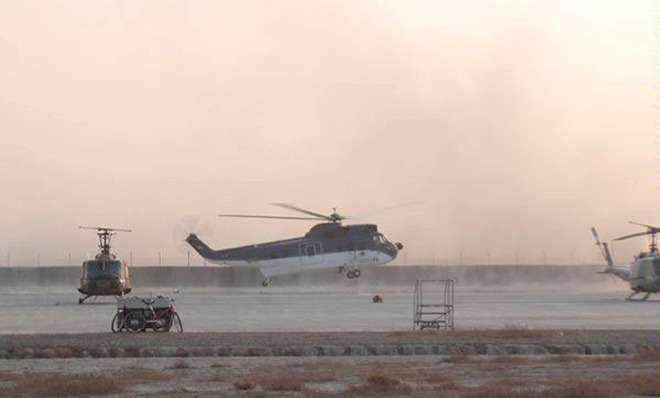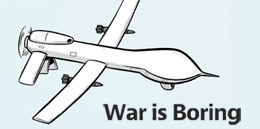The U.S. State Department has its own air force. And it's surprisingly big.
Meet the Air Wing


The U.S. State Department possesses just under 100 helicopters and more than 30 fixed-wing aircraft and deploys them all over the world, mostly as part of the America's international drug war.
The Bureau for International Narcotics and Law Enforcement Affairs' Office of Aviation — a.k.a., the INL Air Wing — employs contractors and foreign government aviators to fly these aircraft in seven countries: Afghanistan, Bolivia, Colombia, Guatemala, Iraq, Pakistan, and Peru.
The main mission of the Air Wing is to assist friendly states in their own fights against illegal drugs and narco-terrorism. However, with its large fleet — larger than the air forces of some NATO members — the Air Wing also trains allied governments and provides general aviation support, including transportation for diplomatic missions.
The Week
Escape your echo chamber. Get the facts behind the news, plus analysis from multiple perspectives.

Sign up for The Week's Free Newsletters
From our morning news briefing to a weekly Good News Newsletter, get the best of The Week delivered directly to your inbox.
From our morning news briefing to a weekly Good News Newsletter, get the best of The Week delivered directly to your inbox.
For instance, an Air Wing DC-3T was spotted in Libya around the time of the attacks on the U.S. consulate in Benghazi in September 2012.
Compared to the military's air arms with their thousands of high-tech aircraft, the Air Wing operates on the cheap with an annual budget of barely $1 billion.
State is currently in the pre-solicitation phase for separate contracts for the Air Wing's operations, logistics, maintenance, and IT. These contractors will support the Air Wing at its headquarters at Patrick Air Force Base in Florida and in the seven countries where it operates full-time.
Helping hands
A free daily email with the biggest news stories of the day – and the best features from TheWeek.com
In five of the seven countries where the Air Wing operates, contractors work with local military and law enforcement personnel and even fly aircraft wearing the national insignia of those nations. Through bilateral agreement, Air Wing contractors work directly with the Bolivian Air Force, the Colombian National Police, the Guatemalan Air Force, the Pakistani Frontier Corps, and the Peruvian National Police.
Only in Iraq and Afghanistan are Air Wing personnel not directly embedded with another force. In many cases, the Air Wing trains foreign troops and cops to maintain and operate the aircraft and then actually transfers the aircraft to them.
This cooperative model means that the Air Wing operates a significant number of refurbished, second-hand aircraft — as well as new but economical types that might be passed on to foreign partners.
These include helicopters like the Huey II, which Bell offers as a rebuild option using donated airframes, plus ex-Marine Corps CH-46 Sea Knights, which the Air Wing has been acquiring as the Marines replace the CH-46s with V-22 tiltrotors.
Fixed-wing assets include the popular Cessna 208 Caravan and the Air Tractor AT-802 crop duster, the latter used to spray herbicides over drug fields. In the last decade, Air Wing Huey IIs and C-27A transports have deployed to Iraq and Afghanistan to help develop the air forces of those countries.
Aerial drug war
State has been flying aircraft in support of counter-narcotics efforts since the 1970s, when it acquired a number of ex-military OV-10 Bronco light-attack aircraft. The Air Wing used these aircraft, with their armament removed, to spray herbicides on drug fields in Colombia, Mexico and Burma.
Efforts in Latin America greatly expanded in the 1980s. By the end of the decade, State was operating specially-built Narcotics Eradication Delivery System aircraft — a variant of the Ayres Turbo Thrush crop duster — from airfields in Belize, Bolivia, Guatemala, and Peru.
These flights were referred to as "Operation Roundup," after the weedkiller. In the 1990s, the program shifted to Colombia, where it remains.
The Air Wing and the State Department in general have become deeply invested in the development of foreign military and police air arms. The mission has become more urgent as the Air Force has tried and failed to acquire its own light planes specifically for training foreign air forces.
Many of the countries that State supports, especially in Africa and Latin America, simply could not afford to operate and maintain advanced jet aircraft or even multi-engine turboprop transports like the ubiquitous C-130.
With its relatively low operating cost, low profile, and easy-to-use equipment, the Air Wing will likely remain a good choice for helping friendly countries fight drugs or build their own air arms.
From drones to AKs, high technology to low politics, War is Boring explores how and why we fight above, on, and below an angry world. Sign up for its daily email update here or to its RSS feed here.
More from War is Boring...
-
 US citizens are carrying passports amid ICE fears
US citizens are carrying passports amid ICE fearsThe Explainer ‘You do what you have to do to avoid problems,’ one person told The Guardian
-
 All roads to Ukraine-Russia peace run through Donetsk
All roads to Ukraine-Russia peace run through DonetskIN THE SPOTLIGHT Volodymyr Zelenskyy is floating a major concession on one of the thorniest issues in the complex negotiations between Ukraine and Russia
-
 Why is Trump killing off clean energy?
Why is Trump killing off clean energy?Today's Big Question The president halts offshore wind farm construction